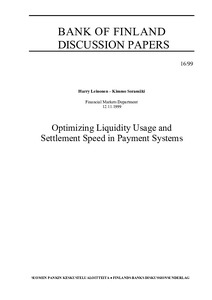Optimizing liquidity usage and settlement speed in payment systems
Leinonen, Harry; Soramäki, Kimmo (12.11.1999)
Numero
16/1999Julkaisija
Suomen Pankki
1999
Julkaisun pysyvä osoite on
https://urn.fi/URN:NBN:fi:bof-20140807510Tiivistelmä
The operating speed of a payment system depends on the stage of technology of the system's communication and information processing environment.Frequent intraday processing cycles and real-time processing have introduced new means of speeding up the processing and settlement of payments.In a real-time environment banks face new challenges in liquidity management.They need to plan for intraday as well as interday fluctuations in liquidity.By employing various types of hybrid settlement structures, banks may be able to even out intraday fluctuations in liquidity demand.The aim of this study is to develop a framework for analysing fluctuations in liquidity demand and assessing the efficiency of different settlement systems in terms of speed and liquidity needs. In this study we quantify the relationship between liquidity usage and settlement delay in net settlement systems, real-time gross settlement systems and hybrid systems, as well as the combined costs of liquidity and delay in these systems.We analyse ways of reducing costs via optimization features such as netting of queues, offsetting of payments and splitting of payments.We employ a payment system simulator developed at the Bank of Finland, which enables us to evaluate the impact of changes in system parameters and thus to compare the effects of alternative settlement schemes with given payment flows.The data used covers 100 days of actual payments processed in the Finnish BoF-RTGS system.Our major findings relate to risk reduction via real-time settlement, effects of optimization routines in hybrid systems, and the effects of liquidity costs on banks' choice of settlement speed.A system where settlement takes place continuously in real-time and with queuing features is more efficient from the perspective of liquidity and risks than a net settlement system with batch processing.Real-time processing enables a reduction in payment delay and risks without necessarily increasing liquidity needs. Participants will operate under immediate payment/settlement if liquidity costs are low enough relative to delay costs and if the liquidity arrangements are sufficiently flexible.The central bank can therefore support risk reduction and payment speed objectives by providing low cost intraday liquidity as well as more flexible ways for participants to add or withdraw liquidity from the system. Optimizing and gridlock solving features were found to be effective at very low levels of liquidity.The efficiency of the different optimization methods for settlement systems are affected by the actual flow of payments processed.Gains from netting schemes with multiple daily netting cycles were found to be somewhat more limited.Key words: payment systems, clearing/settlement, liquidity, efficiency, gridlock
